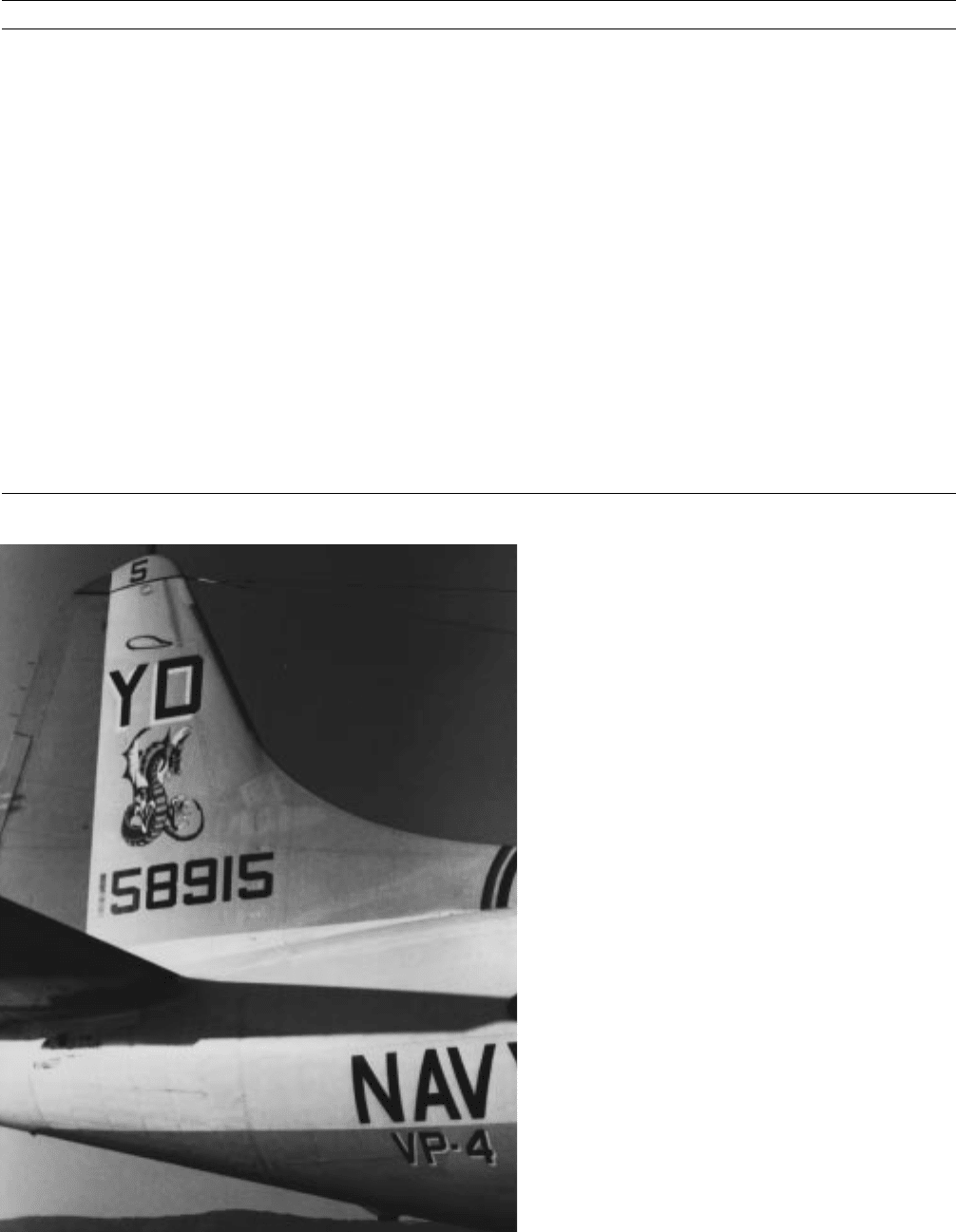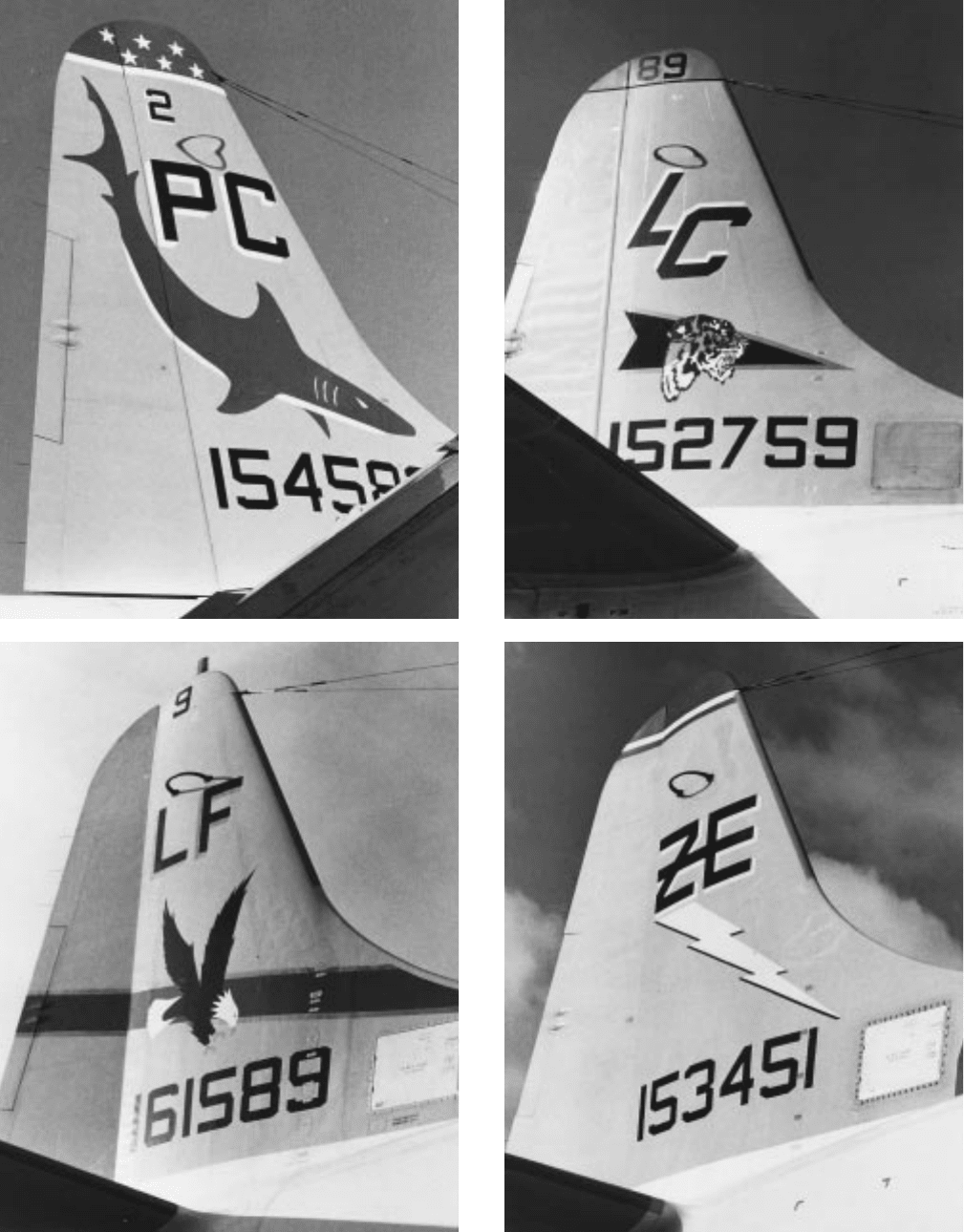Grossnick Roy A. United States Naval Aviation, 1910-1995
Подождите немного. Документ загружается.


MARINE CORPS SQUADRON DESIGNATIONS/ABBREVIATIONS—Continued
Acronym Full Squadron Designation General time-frame in use
VMF(N) Marine Night Fighter Squadron 1942–1958
VMFP Marine Tactical Reconnaissance Squadron 1975–1990
VMFT Marine Fighter Training Squadron 1951–present
VMFT(AW) Marine All-Weather Fighter Training Squadron 1955–1958
VMFT(N) Marine Night Fighter Training Squadron 1951–1958
VMGR Marine Aerial Refueler Transport Squadron 1962–present
VMGRT Marine Aerial Refueling Transport Training Squadron 1986–present
VMIT Marine Instrument Training Squadron 1951–1958
VMJ Marine Utility Squadron 1945–1952
VMJ Marine Photographic Squadron 1952–1955
VML Marine Glider Squadron 1942–1943
VMO Marine Observation Squadron 1941–1993
VMP Marine Photographic Squadron 1946–1949
VMR Marine Transport Squadron 1944–1962
VMS Marine Scouting Squadron 1937–1944
VMSB Marine Scout Bombing Squadron 1941–1946
VMT Marine Training Squadron 1947–present
VMTB Marine Torpedo Bomber Squadron 1943–1946
UNITED STATES NAVAL AVIATION 1910–1995 631
Photograph shows the tail code and insignia used by Patrol
Squadron P-3 Orion aircraft.

632 UNITED STATES NAVAL AVIATION 1910–1995
Photographs show the tail codes and insignia used by Patrol Squadron P-3 Orion aircraft.

Sailors have long studied the sky and have used
the movements of celestial bodies to guide them
across the trackless seas. Realizing the need to observe
the movements of the stars and planets, the U.S. Navy
established the Depot of Charts and Instruments on 6
December 1830. This is the Navy’s oldest scientific
institution. The Depot later became the U.S. Naval
Observatory. Today it continues to provide the astro-
nomical data necessary for navigation at sea, on land
as well as in space.
In 1923 the Naval Research Laboratory (NRL) began
operation. The idea for a U.S. Government-supported
research laboratory was suggested by the American
inventor Thomas Alva Edison during World War I.
Secretary of the Navy Josephus Daniels seized the
opportunity and invited Edison to become head of the
Naval Consulting Board. The Board made plans to cre-
ate a modern scientific research facility, which became
the Naval Research Laboratory. Robert Morris Page
who was at NRL from the late 1920s to the mid-1960s
invented the technology for pulse radar. During World
War II his invention assisted the Allies in detecting
enemy planes and ships. Without radar, today’s space
program would be impossible.
In 1911 the Navy bought its first aircraft—the A-1
Triad. Advances were made in aviation; and aircraft
were flying higher and higher. On 8 May 1929
Lieutenant Apollo Soucek set the world altitude record
for landplanes by flying a Wright Apache to the height
of 39,140 feet. On 4 June 1929, the same Lieutenant
Souceck set the altitude record for seaplanes, also in
an Apache, reaching the height of 38,560.
Altitude records were now approaching the 40,000-
foot range. At these heights, the thin air and decreased
pressure made it difficult for human beings to function
and survive. The airplane was a poor vehicle in which
to study the upper reaches of the atmosphere. The
balloon proved to be more suitable.
On 4 August 1933 Lieutenant Commander Thomas
“Tex” Settle ascended aloft in the sealed life-support
gondola of a balloon, but the attempt failed. A similar
attempt in a balloon by Soviet aeronauts the following
September, achieved the height of 62,230 feet. The
space race between the United States and the Soviet
Union had begun.
UNITED STATES NAVAL AVIATION 1910–1995 633
633
APPENDIX 17
The Navy in Space
On 20 November 1933, Lieutenant Commander
Thomas “Tex” Settle and Major Chester L. Fordney,
USMC, flying a 600,000 cubic-foot free balloon, set the
world’s altitude record of 61,237 feet. It was an official
world’s record, but 1,000 feet shy of the actual Soviet
achievement.
In December 1941, the United States entered World
War II with no rocket weapons. Germany was putting
a great deal of its effort into the development of rock-
ets, basing much of its technology on the research of
the American scientist Robert H. Goddard.
At the end of the war, the U.S. rocket budget was
1.3 million. Research in the use of rockets in jet-assist-
ed take off (JATO) had been carried out by U.S. rocket
pioneer Robert Goddard, assisted by the Navy’s Robert
Truax. In May 1943 a JATO-equipped Catalina (PBY)
made its first successful flight. JATO could reduce the
takeoff run by 33 to 60 percent, or permit greater pay-
loads. The JATO program laid the groundwork for the
use of rocket power in Navy guided missiles.
After World War II, U.S. interest in high altitude
research experiments resumed. The Office of Naval
Research (ONR) made plans for a manned balloon
flight into the upper atmosphere. Project Helios called
for the construction of plastic balloons with a gondola
equipped with scientific observation instruments. This
ambitious plan was replaced in 1947 by Project
Skyhook, which used polyethylene balloons to carry
instrument packages to extreme altitudes. Thousands
of these balloons were sent into the stratosphere for
basic research.
In 1952 a new technique was developed in which
Deacon rockets were lifted above 70,000 feet by
Skyhook balloons and then fired into space. The
Skyhook experiments proved to be so successful that
in 1954 plans were made to entrust the lives of men to
the Skyhook balloons.
Project Stratolab, a laboratory in the stratosphere,
began in 1955. On 8 November 1956, Stratolab I,
manned by Lieutenant Commanders Malcolm D. Ross
and Morton Lee Lewis reached a record altitude of
76,000 feet. It would not, however, be with the bal-
loon that man would reach space. It would be with
the rocket.
Naval Research Laboratory scientists had been con-
ducting experiments on the Aerobee and Viking
sounding rockets during the early 1950s. An NRL study
in 1954 indicated the feasibility of successfully placing
a satellite in orbit, using a vehicle based on the Viking
as a first stage and the Aerobee as the second.
In 1955 President Eisenhower announced that the
United States would launch “small, unmanned, earth-
circling satellites” as a part of the U.S. contributions to
the International Geophysical Year 1957–58. The Naval
Research Laboratory proposed that the Vanguard rock-
et, based on Viking technology, be used to launch the
satellite. The NRL proposal was accepted. Project
Vanguard was to have three missions: place at least
one satellite in orbit during 1957–58; accomplish a sci-
entific experiment in space; and track the flight to
demonstrate that the satellite had actually attained
orbit.
Before Vanguard could launch a satellite into space,
however, the Soviets announced that they had put
Sputnik into orbit on 4 October 1957. Sputnik, the
Russian word for travelling companion, was the earth’s
first artificial satellite. The perception by the United
States that it was the leader in space technology was
shattered, and the capability of Soviet rockets to fire
weapons from space became apparent.
On 31 January 1958 the Army’s Jupiter-C rocket, a
further development of the Redstone rocket, put the
first U.S. satellite, Explorer I into orbit. On 31 March
1958, a Vanguard rocket fired from Cape Canaveral,
Fla., put a second earth satellite into orbit.
In response to the Soviet challenge in space, the
United States established the National Aeronautics and
Space Administration (NASA) in July 1958. Project
Mercury would put a man into space. On 15 May
1961, President John F. Kennedy went even further
and stated in an address to Congress that the United
States would commit itself to landing a man on the
moon by the end of the decade. This goal was named
Project Apollo.
NASA lobbed a chimpanzee into space on 31
January 1961. After this experiment proved successful,
it was then believed that it was possible to put a man
into a similar sub-orbital trip. Commander Alan B.
Shepard, Jr., USN, was chosen to be the first American
sent into space.
On 5 May 1961, Commander Shepard left earth’s
atmosphere in the Freedom 7 space capsule. It was a
ballistic “cannon shot” with an Army Redstone rocket.
The space capsule was recovered at sea by an HUS-1
helicopter from Marine Corps Squadron HMR(L)-262,
which transported the capsule and Commander
Shepard to the carrier Lake Champlain.
Subsequent Mercury missions put other men in
space. On 20 February 1962, Lieutenant Colonel John
634 UNITED STATES NAVAL AVIATION 1910–1995
H. Glenn, Jr., USMC, and his spacecraft Friendship 7
made three orbits around the earth. Other men were
sent singly into space. Then, during 1965 and 1966,
Project Gemini sent up two men at a time. Many were
Naval Aviators.
After having succeeded in putting men into space,
NASA concentrated on putting a man on the moon. In
December 1968 Lieutenant Commander James A.
Lovell, Jr., USN, was on the Apollo 8 flight that flew to
the moon and circled around it, viewing the side that
is never seen from earth. On 20 July 1969 Neil A.
Armstrong, a naval aviator, became the first man to
walk on the moon during the Apollo 11 flight.
The next U.S space goal was to explore space in
Skylab, a space laboratory in which the astronauts
could live a fairly normal life, work on scientific
experiments, eat, sleep, and have regular periods of
recreation. Three separate crews of Skylab astronauts
were launched into space in 1973. Two of the three
were all-Navy crews.
Meanwhile the Apollo space trips continued. The
last Apollo mission was launched on 15 July 1975.
Vance D. Brand, a former Navy pilot, was the com-
mand module pilot. On this space trip, Apollo docked
with the Soviet Soyuz spacecraft. This was the first
meeting between American astronauts and Soviet cos-
monauts in space. The two crews then conducted sci-
entific experiments in space. Apollo splashed down in
the Pacific near Hawaii and was recovered by New
Orleans. This was the last splash-down recovery by a
Navy amphibious ship. The Space Shuttle would make
splash-down recoveries unnecessary.
The Space Shuttle was launched by a rocket, but
could land like an airplane, thus it could make multi-
ple trips into space. Columbia was the first Space
Shuttle and was launched on 12 April 1981 with an all
Navy-aviator crew. Space Shuttle Columbia was fol-
lowed by Space Shuttles Challenger, Discovery,
Atlantis, and Endeavour. Subsequent Space Shuttle
flights were able to take more and more astronauts on
a single flight into space and stay in space for longer
periods of time and continue to conduct scientific
experiments. Limited cooperation with the Russian
Republic, part of the former Soviet Union also contin-
ued. In 1995 Space Shuttle Atlantis transported two
Russian cosmonauts to the Russian space station Mir
where American astronaut Norman Thagard, a former
naval aviator, had been living for three months.
Atlantis docked with Mir and brought Norman
Thagard back to earth.
Naval Aviation continues to play an important role
in space. The following three sections provide statisti-
cal data on Naval Aviation’s contributions or involve-
ment in the manned space program.
Andrew M. Allen
Scott Altman
Neil A. Armstrong*
Jeffery Ashby
Michael A. Baker
Alan L. Bean
Charles F. Bolden, Jr.
Kenneth D. Bowersox
Vance D. Brand*
Daniel C. Brandenstein
James F. Buchli
John S. Bull
Daniel W. Bursch
Robert D. Cabana
Kenneth D. Cameron
Malcolm Scott Carpenter
Gerald P. Carr
Manley L. Carter, Jr.
Eugene A. Cernan
Roger B. Chaffee
Michael L. Coats
Kenneth Cockrell
Charles Conrad, Jr.
John O. Creighton
Robert L. Crippen
Frank L. Culbertson
R. Walter Cunningham*
Robert Curbeam
Joe F. Edwards
Ronald E. Evans
Dale A. Gardner
Jake E. Garn*
Robert L. Gibson
John H. Glenn, Jr.
Richard F. Gordon, Jr.
Dominic L. Gorie
S. David Griggs
Fred W. Haise, Jr.*
Frederick H. Hauck
Kathryn Hire
David C. Hilmers
UNITED STATES NAVAL AVIATION 1910–1995 635
Brent W. Jett
Joseph P. Kerwin
Wendy B. Lawrence
David C. Leestma
Don L. Lind
Michael E. Lopez-Alegria
John M. Lounge*
John R. Lousma
James A. Lovell, Jr.
Jon A. McBride
Bruce McCandless II
Michael J. McCulley
Thomas K. Mattingly II
Edgar D. Mitchell
Franklin Story Musgrave*
Carlos Noriega
Bryan D. O’Connor
Stephen S. Oswald
Robert F. Overmyer
William F. Readdy
Kenneth S. Reightler, Jr.
Richard N. Richards
Kent V. Rominger
Walter M. Schirra, Jr.
Winston E. Scott
Elliot M. See
Alan B. Shepard, Jr.
Michael John Smith
Robert C. Springer
Susan L. Still
Frederick W. Stuckow
Norman E. Thagard
Stephen D. Thorne
Pierre J. Thuot
Richard H. Truly
James D. van Hoften
David M. Walker
Paul J. Weitz
James D. Wetherbee
Clifton C. Williams
Donald E. Williams
John W. Young
Naval Aviation Personnel Who Have Become Astronauts
(Names with an asterisk (*) are Naval Aviators or Naval Aviation personnel but were no longer on
active duty when involved in the space program)
Naval Aviation Personnel Who Have Made Trips Into Space and
the Number of Flights Made By Each as of 31 December 1995
(Names with an asterisk (*) are former Navy)
636 UNITED STATES NAVAL AVIATION 1910–1995
One Flight
Malcolm Scott Carpenter
Gerald P. Carr
Manley L. Carter, Jr.
R. Walter Cunningham*
Ronald E. Evans
Jake E. Garn*
John H. Glenn, Jr.
S. David Griggs
Fred W. Haise, Jr.*
Joseph P. Kerwin
Wendy B. Lawrence
Don L. Lind
Michael E. Lopez-Alegria
Jon A. McBride
Michael J. McCulley
Edgar D. Mitchell
Kent V. Rominger
Michael John Smith
Two Flights
Andrew M. Allen
Neil A. Armstrong*
Alan L. Bean
Daniel W. Bursch
Kenneth Cockrell
Frank L. Culbertson
Dale A. Gardner
Richard F. Gordon, Jr.
Bruce McCandless II
John R. Lousma
Bryan D. O’Connor
Robert F. Overmyer
William F. Readdy
Kenneth S. Reightler, Jr.
Alan B. Shepard, Jr.
Robert C. Springer
Richard H. Truly
James D. van Hoften
Paul J. Weitz
Donald E. Williams
Three Flights
Michael A. Baker
Kenneth D. Bowersox
Robert D. Cabana
Kenneth D. Cameron
Eugene A. Cernan
Michael L. Coats
John O. Creighton
Frederick H. Hauck
David C. Leestma
John M. Lounge*
Thomas K. Mattingly II
Stephen S. Oswald
Walter M. Schirra, Jr.
Pierre J. Thuot
James D. Wetherbee
Four Flights
Charles F. Bolden, Jr.
Vance D. Brand*
Daniel C. Brandenstein
James F. Buchli
Charles Conrad, Jr.
Robert L. Crippen
David C. Hilmers
James A. Lovell, Jr.
Richard N. Richards
David M. Walker
Five Flights
Robert L. Gibson
Franklin Story Musgrave*
Norman E. Thagard
Six Flights
John W. Young

List of U.S. Space Flights with Navy/Marine Corps
Pilots/Astronauts Aboard
(As of 31 Dec 1995)
Order Date Designation Crew (see notes) Duration
1 5 May 61 Mercury Redstone 3 Alan B.Shepard,Jr. 15 min
(Freedom 7) (1st U.S. 22 sec
man into space,
sub-orbital)
3 20 Feb 62 Mercury Atlas 6 John H.Glenn,Jr., USMC 4 hrs
(Friendship 7) 55 min
(1st American to 23 sec
orbit the earth)
4 24 May 62 Mercury Malcolm Scott Carpenter 4 hr
Atlas 7 56 min
(Aurora 7) 5 sec
5 3 Oct 62 Mercury Walter M.Schirra, Jr. 9 hrs
Atlas 8 13 min
(Sigma 7) 11 sec
7 23 Mar 65 Gemini 3 Virgil I. Grissom,USAF 4 hrs
John W.Young 53 min
9 21–29 Aug 65 Gemini 5 Leroy G.Cooper,Jr.,USAF 190 hrs
Charles Conrad,Jr. 56 min
1 sec
10 4–18 Dec 65 Gemini 7 Frank Borman,USAF 330 hrs
James A.Lovell,Jr. 35 min
13 sec
11 15–16 Dec 65 Gemini 6 Walter M.Schirra,Jr. 25 hrs
Thomas P.Stafford,USAF 51 min
24 sec
12 16 Mar 66 Gemini 8 Neil A.Armstrong* 10 hrs
David R. Scott, USAF 42 min
6 sec
13 3–6 Jun 66 Gemini 9 Thomas P. Stafford,USAF 72 hrs
Eugene A.Cernan 20 min
56 sec
14 18–21 Jul 66 Gemini 10 John W.Young 70 hrs
Michael Collins,USAF 46 min
45 sec
15 12–15 Sep 66 Gemini 11 Richard F.Gordon,Jr. 71 hrs
Charles Conrad,Jr. 17 min
8 sec
16 11–15 Nov 66 Gemini 12 James A. Lovell,Jr. 94 hrs
Edwin E.Aldrin,Jr.,USAF 34 min
31 sec
UNITED STATES NAVAL AVIATION 1910–1995 637

List of U.S. Space Flights with Navy/Marine Corps Pilots/Astronauts Aboard—Continued
Order Date Designation Crew (see notes) Duration
17 11–22 Oct 68 Apollo 7 Walter M.Schirra,Jr. 206 hrs
Donn F. Eisele,USAF 9 min
R.Walter Cunningham*
18 21–27 Dec 68 Apollo 8 Frank Borman,USAF 147 hrs
(1st flight James A.Lovell, Jr. 0 min
to the moon) William A.Anders, USAF 42 sec
20 18–26 May 69 Apollo 10 Thomas P. Stafford,USAF 192 hrs
John W.Young 3 min
Eugene A.Cernan 23 sec
21 16–24 Jul 69 Apollo 11 Neil A.Armstrong* 195 hrs
(first moon walk) Michael Collins, USAF 18 min
Edwin E.Aldrin,Jr.,USAF 35 sec
22 14–24 Nov 69 Apollo 12 Charles Conrad,Jr. 244 hrs
(all Navy crew) Richard F.Gordon,Jr. 36 min
Alan L.Bean 25 sec
23 11–17 Apr 70 Apollo 13 James A.Lovell,Jr. 142 hrs
John L.Swigert,Jr.(civ) 54 min
Fred W. Haise,Jr.* 41 sec
24 31 Jan–9 Feb 71 Apollo 14 Alan B. Shepard,Jr. 216 hrs
Stuart A.Roosa,USAF 1 min
Edgar D.Mitchell 57 sec
26 16–27 Apr 72 Apollo 16 John W.Young 265 hrs
Thomas K.Mattingly II 1 min
Charles M.Duke,Jr.,USAF 5 sec
27 7–19 Dec 72 Apollo 17 Eugene A. Cernan 301 hrs
Ronald E.Evans 51 min
Harrison H.Schmitt (civ) 59 sec
28 25 May–22 Jun 73 Skylab 2 Charles Conrad,Jr. 672 hrs
(1st U.S.manned Joseph P. Kerwin 49 min
orbiting space station; Paul J.Weitz 49 sec
all-Navy crew)
29 28 Jul–25 Sep 73 Skylab 3 Alan L. Bean 1427 hrs
Owen K.Garriott** 9 min
John R.Lousma,USMC 4 sec
30 16 Nov 73–8 Feb 74 Skylab 4 Gerald P. Carr,USMC 2017 hrs
Edward G.Gibson (civ) 15 min
William R.Pogue,USAF 32 sec
31 15–24 Jul 75 Apollo-Soyuz Thomas P.Stafford, USAF 217 hrs
test project Vance D.Brand* 28 min
Donald K.Slayton,USAF 24 sec
638 UNITED STATES NAVAL AVIATION 1910–1995

List of U.S. Space Flights with Navy/Marine Corps Pilots/Astronauts Aboard—Continued
Shuttle Flights Date Designation Crew (see notes)
STS-1 12–14 Apr 81 Space Shuttle
Columbia
John W.Young*
(1st mission into space, Robert L. Crippen
all-Navy crew)
STS-2 12–14 Nov 81 Space Shuttle
Columbia
Richard H.Truly
Joseph H.Engle,USAF
STS-3 22–30 Mar 82 Space Shuttle
Columbia
John R.Lousma,USMC
Charles G.Fullerton,USAF
STS-4 27 Jun–4 Jul 82 Space Shuttle
Columbia
Thomas K.Mattingly II
Henry W. Hartsfield, USAF
STS-5 11–16 Nov 82 Space Shuttle
Columbia
Vance D.Brand*
Robert F. Overmyer, USMC
William B.Lenoir (civ)
Joseph P.Allan (civ)
STS-6 4–9 Apr 83 Space Shuttle
Challenger
Paul J.Weitz*
Karol J.Bobko,USAF
Donald H.Peterson,USAF
Franklin Story Musgrave*
STS-7 18–24 Jun 83 Space Shuttle
Challenger
Robert L.Crippen
Frederick H.Hauck
John M.Fabian,USAF
Sally K.Ride (civ)
Norman E.Thagard*
STS-8 30 Aug–5 Sep 83 Space Shuttle
Challenger
Richard H.Truly
Daniel C.Brandenstein
Dale A.Gardner
Guion S.Bluford,Jr.,USAF
William E.Thornton (civ)
STS-9 28 Nov–8 Dec 83 Space Shuttle
Columbia
John W.Young*
Brewster H.Shaw, Jr.,USAF
Owen K.Garriott**
Robert A.R.Parker (civ)
Ulf Merbold (civ)
+
Byron K.Lichtenberg(civ)
+
STS-41-B 3–11 Feb 84 Space Shuttle
Challenger
Vance D.Brand*
(1st untethered Bruce McCandless II
walk in space) Robert L.Gibson
Robert L.Steward,USA
Ronald E.McNair (civ)
UNITED STATES NAVAL AVIATION 1910–1995 639

List of U.S. Space Flights with Navy/Marine Corps Pilots/Astronauts Aboard—Continued
Shuttle Flights Date Designation Crew (see notes)
STS-41-C 6–13 Apr 84 Space Shuttle
Challenger
Robert L.Crippen
Francis R.Scobee, USAF
George D.Nelson (civ)
Terry J. Hart,USAF
James D.van Hoften
STS-41-D 30 Aug–5 Sep 84 Space Shuttle
Discovery
Henry W. Hartsfield, USAF
Michael L.Coats
Judith A.Resnick (civ)
Steven A.Hawley (civ)
Richard M.Mullane,USAF
Charles D.Walker (civ)
+
STS-41-G 5–13 Oct 84 Space Shuttle
Challenger
Robert L.Crippen
Jon A.McBride
Kathryn D.Sullivan (civ)
Sally K.Ride (civ)
David C. Leestma
Marc Garneau (civ)
+
Paul D.Scully-Power(civ)
+
STS-51-A 8–15 Nov 84 Space Shuttle
Discovery
Frederick H.Hauck
David M.Walker
Anna L.Fisher (civ)
Joseph P.Allen (civ)
Dale A.Gardner
STS-51-C 24–27 Jan 85 Space Shuttle
Discovery
Thomas K.Mattingly II
Loren J.Shriver,USAF
Ellison S.Onizuka,USAF
James F. Buchli,USMC
Gary E. Payton,USAF
+
STS-51-D 12–19 Apr 85 Space Shuttle
Discovery
Karol J.Bobko,USAF
Donald E.Williams
Margaret Rhea Seddon (civ)
Jeffrey A.Hoffman (civ)
S.David Griggs
Charles D.Walker (civ)
+
Jake E.Garn*
++
STS-51-B 29 Apr–6 May 85 Space Shuttle
Challenger
Robert F. Overmyer, USMC
Frederick D.Gregory, USAF
Don L.Lind
Norman E.Thagard*
William E.Thornton (civ)
Lodewijk van den Berg(civ)
+
Taylor G.Wang (civ)
+
640 UNITED STATES NAVAL AVIATION 1910–1995
